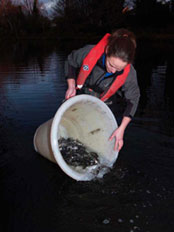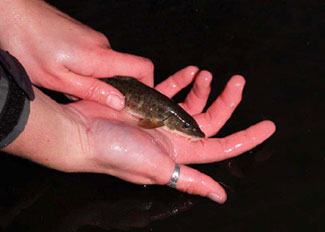Environment Agency fisheries officers released nearly 5,000 juvenile fish into the River Wandle on Thursday 6 December 2007, in an attempt to rejuvenate the river devastated by a pollution incident earlier this year. The release marks the first stage in what will be a long term restoration process.
The batches of one to two year-old chub, dace, roach and barbel were specially reared and trained for life in the wild at the Environment Agency’s Calverton Fish Farm in Nottinghamshire and were released in three areas along the river.
In September 2007, a chemical spill killed tens of thousands of fish of varying ages, sizes and species along a five km stretch of the River Wandle between Beddington and Merton. The incident generated an enormous amount of public concern and the Environment Agency has been working closely with local anglers, the Anglers Conservation Association, the National Trust, the Wandle Trust, Thames Water Utilities Ltd and independent surveyors to determine the impact of the spill and decide on the most effective way to rehabilitate the river.
Post-pollution survey work by independent contractor (APEM) and the Environment Agency has shown that some species of fish were completely wiped out in the upper reaches of the river, closest to the pollutant’s origin. However, at the very bottom of the affected five km stretch, some fish survived.
 |
| Fisheries officer Tanya Houston at the Wandle restocking. |
 |
| Looks like a mini barbel to us, either that or a world record gudgeon! |
Theo Pike of the Wandle Trust said:
“The recent surveys have confirmed the serious impact of the pollution, but they have also demonstrated that there is adequate food and shelter for this limited initial restocking. This is important because we need to give nature a helping hand to restore fish stocks as there are many barriers to the free movement of fish up and down the river, meaning natural recolonisation would be very slow.
Tom Cousins, one of the fisheries officers who will assist with the release of the new fish, said:
“Although it is important that the river is restocked so that we can spur on recovery and improve the river we need to remember that the size, quality and number of fish lost in the pollution incident means that it is impossible to physically buy or collect equivalent fish from elsewhere. It will take several years before these fish will be of a size to be of interest to recreational fishermen, and many years before they approach the size of those fish lost in the pollution incident.
“Analysis of scales taken from some of the fish carcasses that were collected in the aftermath of the pollution incident, show that the fish in the Wandle were above average in size when compared with that expected in similar rivers in the South of England. This is because the river was considered a highly productive river system, containing plenty of food for the fish.”
Despite these first steps towards nursing the river back to health, team leader for the Environment Agency Mike Denbigh commented:
“The Environment Agency plays a dual role in this situation. Although we are happy that restocking has begun, our investigation into this unfortunate incident is progressing well and we are preparing a case file for our legal department. With incidents of this severity it is the Environment Agency’s policy to fully investigate the incident and, where possible, to gather evidence for submission. Our Enforcement and Prosecution Policy and Guidance indicates that, where the evidence exists, the normal response to such an incident is to prosecute where the likely offender is identified. Carrying out a robust investigation and undertaking legal action is not a quick process.”






